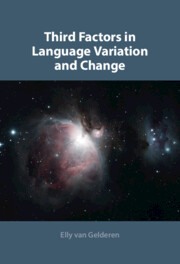Book contents
- Third Factors in Language Variation and Change
- Third Factors in Language Variation and Change
- Copyright page
- Contents
- Figures
- Tables
- Preface
- Abbreviations
- 1 The Shift towards a Minimal UG
- 2 Labeling in Language Change
- 3 Determinacy in Language Variation
- 4 Determinacy in Language Change
- 5 Labeling and Determinacy: Verb-Second and Expletives
- 6 Adjunct Incorporation and Avoiding Pair-Merge
- 7 Conclusion
- References
- Index
6 - Adjunct Incorporation and Avoiding Pair-Merge
Published online by Cambridge University Press: 16 December 2021
- Third Factors in Language Variation and Change
- Third Factors in Language Variation and Change
- Copyright page
- Contents
- Figures
- Tables
- Preface
- Abbreviations
- 1 The Shift towards a Minimal UG
- 2 Labeling in Language Change
- 3 Determinacy in Language Variation
- 4 Determinacy in Language Change
- 5 Labeling and Determinacy: Verb-Second and Expletives
- 6 Adjunct Incorporation and Avoiding Pair-Merge
- 7 Conclusion
- References
- Index
Summary
Chapter 6 discusses another issue in efficient computations that language change casts some light on, namely through changes affecting adjuncts. Chomsky (2000, 2001) distinguishes between arguments (subjects and objects) and adverbials in terms of ordered pair-merge and unordered set-merge, respectively. I examine changes of VP and NP adjuncts to specifiers positions of functional categories (ASPP and DP, respectively) and of adjuncts to arguments. These changes show that pair-merge can be avoided. Adjuncts that are in specifier positions of functional categories in their turn reanalyze as heads, driven by labeling pressures. I also address the question of whether subordinate and insubordinate adjunct clauses change in unidirectional ways, and conclude that they don’t.
- Type
- Chapter
- Information
- Third Factors in Language Variation and Change , pp. 159 - 197Publisher: Cambridge University PressPrint publication year: 2021

